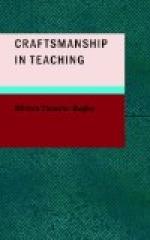I have a theory which I have never exploited very seriously, but I will give it to you for what it is worth. It is this: elementary education especially needs a literary interpretation. It needs a literary artist who will portray to the public in the form of fiction the real life of the elementary school,—who will idealize the technique of teaching as Kipling idealized the technique of the marine engineer, as Balzac idealized the technique of the journalist, as Du Maurier and a hundred other novelists have idealized the technique of the artist. We need some one to exploit our shop-talk on the reading public, and to show up our work as you and I know it, not as you and I have been told by laymen that it ought to be,—a literature of the elementary school with the cant and the platitudes and the goody-goodyism left out, and in their place something of the virility, of the serious study, of the manful effort to solve difficult problems, of the real and vital achievements that are characteristic of thousands of elementary schools throughout the country to-day.
At first you will be fascinated by the novelty of your work. But that soon passes away. Then comes the struggle,—then comes the period, be it long or short, when you will work with your eyes upon the clock, when you will count the weeks, the days, the hours, the minutes that lie between you and vacation time. Then will be the need for all the strength and all the energy that you can summon to your aid. Fail here, and your fate is decided once and for all. If, in your work, you never get beyond this stage, you will never become the true craftsman. You will never taste the joy that is vouchsafed the expert, the efficient craftsman.
The length of this period varies with different individuals. Some teachers “find themselves” quickly. They seem to settle at once into the teaching attitude. With others is a long, uphill fight. But it is safe to say that if, at the end of three years, your eyes still habitually seek the clock,—if, at the end of that time, your chief reward is the check that comes at the end of every fourth week,—then your doom is sealed.




